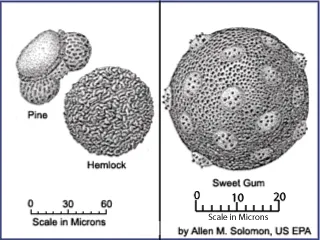Pollen Picture

Allen M. Solomon, US EPA
Pine, Hemlock and Sweet Gum pollen grains.
Scientists can study climates of the past - even during times before people were around to observe the climate. Pollen from trees and other plants blows into lakes, sinks to the bottom, and gets trapped in the mud there. By looking at the different types of pollen in layers of mud in lake bottoms, scientists can determine what kinds of plants grew near the lake at different times in the past. In turn, evidence for different types of plants tells us about the climate of the past, since some plants are more common in wetter or drier or warmer or cooler conditions.